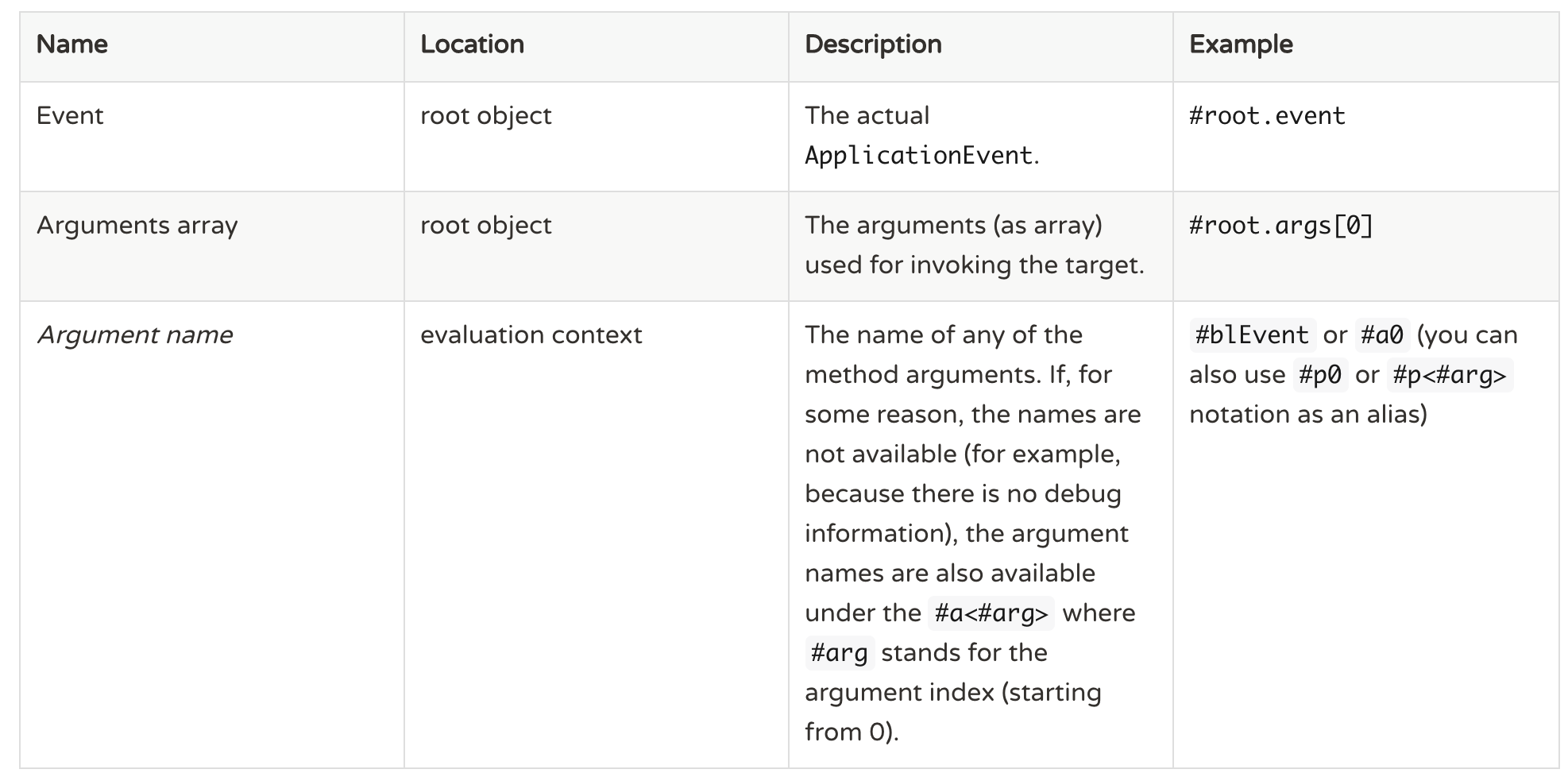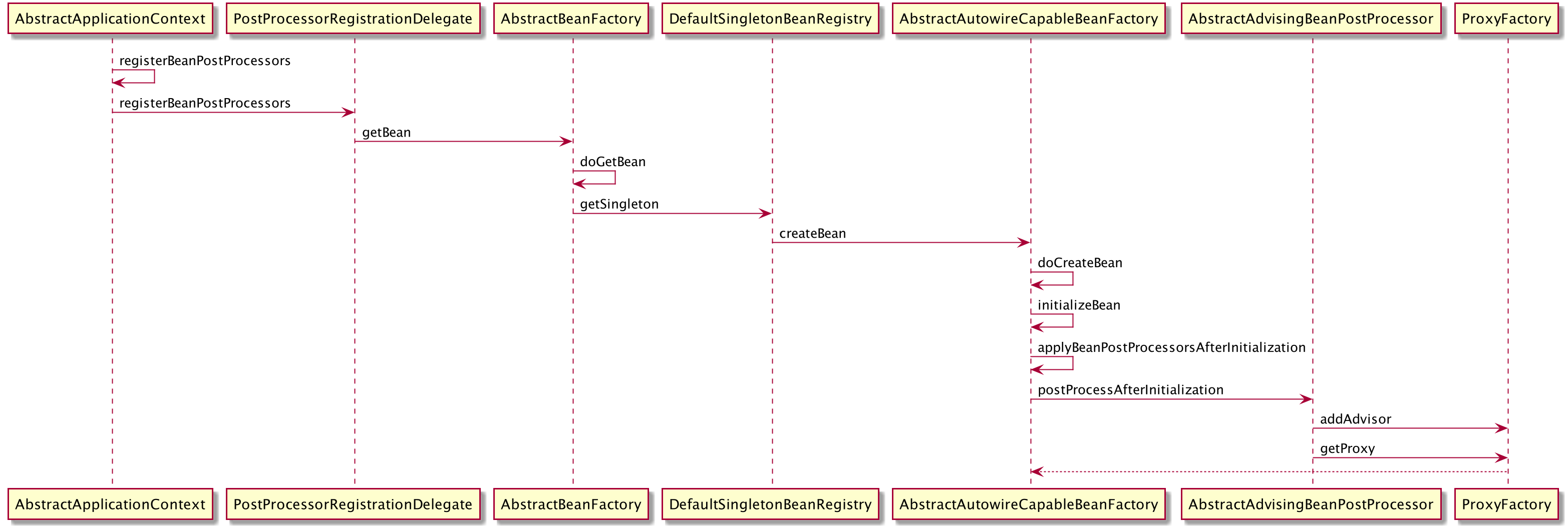SpringBoot 事件
SpringBoot事件其实不是什么新鲜事,是基于SpringFramework的事件机制
- ApplicationEvent 事件(消息)
- ApplicationStartingEvent
- ApplicationEnvironmentPreparedEvent
- ApplicationContextInitializedEvent
- ApplicationPreparedEvent
- ContextRefereshedEvent (SpringFramework)
- ServletWebServerInitializedEvent
- ApplicationStartedEvent
- ApplicationReadyEvent
- ContextClosedEvent (SpringFramework)
- ApplicationFailedEvent
- ApplicationListener 事件监听器(消费者/订阅者)
- ApplicationEventMulticaster 事件发布者(生产者/发布者)
- SimpleApplicationEventMulticaster (默认发布者实现类)
注意:
Spring的事件缺省是同步的机制,但也提供异步的方式。其中异步机制采用线程池的方式来完成的,线程池由用户配置。
Spring 事件注解
As of Spring 4.2, you can register an event listener on any public method of a managed bean by using the
EventListenerannotation.
Spring4.2之后,你可以通过使用@EventListener注解在任何被托管的bean的公开方法注册一个事件监听器
EventListener使用
1
2
3
4
@EventListener({ContextStartedEvent.class, ContextRefreshedEvent.class})
public void handleContextStart() {
...
}
通常我们有时候会需要通过条件属性去过滤事件,你只要编写一下SpEL expression,它能够让你针对特定的条件去执行特定的处理
1
2
3
4
@EventListener(condition = "#blEvent.content == 'my-event'")
public void processBlackListEvent(BlackListEvent blEvent) {
...
}
以下列出Event SpEL的元数据

如果你想收到事件A后发布事件B,你可以修改你的参数签名返回一个事件B
1
2
3
4
5
@EventListener
public ListUpdateEvent handleBlackListEvent(BlackListEvent event) {
// notify appropriate parties via notificationAddress and
// then publish a ListUpdateEvent...
}
注意:这个特性不适合异步事件监听器
如果想返回一系列的事件,你可以在返回Collection
异步事件监听器
如果你想使用特定的监听器去异步处理事件。你需要使用@Async支持,需要开启@EnableAsync
1
2
3
4
5
@EventListener
@Async
public void processBlackListEvent(BlackListEvent event) {
//BlackListEvent is processed in a separate thread
}
当使用异步化事件需要注意如下限制:
- 如果事件监听器抛出异常,这个异常是不会传播给调用者,也就是调用者不会捕获到这个异常,具体细节可以查看
AsyncUncaughtExceptionHandler - 此类事件监听器无法发送回复,如果有这个需求,请注入
ApplicationEventPublisher手动发送事件
顺序事件监听器
如果你有两个事件监听器同时监听一个事件,并且是有顺序要求,可以使用@Order
1
2
3
4
5
@EventListener
@Order(42)
public void processBlackListEvent(BlackListEvent event) {
//Notify appropriate parties via notificationAddress...
}
通用事件
通用事件即自定义事件,比如EntityCreatedEvent
1
2
3
4
@EventListener
public void onPersonCreated(EntityCreatedEvent<Person> event) {
...
}
在某些情况下,如果所有事件的事件源都是同一种结构体,那操作起来可能会有点繁琐。这种情况下,你可以实现ResolvableTypeProvider来引导框架提供超出运行时环境提供的范围。
1
2
3
4
5
6
7
8
9
10
public class EntityCreatedEvent<T> extends ApplicationEvent implements ResolvableTypeProvider {
public EntityCreatedEvent(T entity) {
super(entity);
}
@Override
public ResolvableType getResolvableType() {
return ResolvableType.forClassWithGenerics(getClass(), ResolvableType.forInstance(getSource()));
}
}
这个不仅适用于ApplicationEvent,也适用于事件发送的任意对象
EventListener原理
事件监听器的注册
1
2
3
上下文在启动的时候。初始化完整个bean工厂,并实例化所有单例bean,会把调用SmartInitializingSingleton的afterSingletonsInstantiated()方法。
EventListenerMethodProcessor把EventListener注解的Method方法通过简单工厂方法包装成ApplicationListenerMethodAdapter,然后加入到AbstractApplicationContext中

1
2
3
4
5
6
7
8
9
10
11
12
13
14
15
16
17
18
19
20
21
22
23
24
25
26
27
28
29
30
31
32
33
34
public class EventListenerMethodProcessor implements SmartInitializingSingleton {
...
public void afterSingletonsInstantiated() {
...
String beanNames = beanFactory.getBeanNamesForType(Object.class);
//遍历处理每个bean里面的@EventListener
for (String beanName : beanNames) {
...
proccessBean(beanName, type);
...
}
...
}
private void processBean(final String beanName, final Class<?> targetType) {
...
//拿到@EventListener注解的方法
annotatedMethods = MethodIntrospector.selectMethods(targetType,
(MethodIntrospector.MetadataLookup<EventListener>) method ->
AnnotatedElementUtils.findMergedAnnotation(method, EventListener.class));
...
for (Method method : annotatedMethods.keySet()) {
...
//通过简单工厂模式创建出ApplicationListener
ApplicationListener<?> applicationListener =
factory.createApplicationListener(beanName, targetType, methodToUse);
...
//加入到上下文中
context.addApplicationListener(applicationListener);
}
}
...
}
AbstractApplicationContext持有一个事件分发器。通过上下文把事件监听器注册到事件分发器上。
1
2
3
4
5
6
7
8
9
10
11
12
13
14
15
16
17
18
public class AbstractApplicationContext {
...
@Nullable
private ApplicationEventMulticaster applicationEventMulticaster;
private final Set<ApplicationListener<?>> applicationListeners = new LinkedHashSet<>();
...
@Override
public void addApplicationListener(ApplicationListener<?> listener) {
Assert.notNull(listener, "ApplicationListener must not be null");
if (this.applicationEventMulticaster != null) {
//向事件分发器注册
this.applicationEventMulticaster.addApplicationListener(listener);
}
this.applicationListeners.add(listener);
}
}
异步机制
Spring异步是通过aop实现的,缺省的织入模式是AdviceMode.PROXY。会自动导入AsyncAnnotationBeanPostProcessor。
AsyncAnnotationBeanPostProcessor持有AsyncAnnotationAdvisor对象。AsyncAnnotationAdvisor会创建一个AnnotationAsyncExecutionInterceptor拦截器,所有@Async的方法,在调用的时候,都会被这个拦截器拦截,并拿到一个AsyncTaskExecutor线程池,在线程池中执行原方法。
带AsyncAnnotationAdvisor的proxy加载过程

顺序事件监听器原理
1
2
3
4
5
6
7
8
9
10
11
12
13
public class ApplicationListenerMethodAdapter implements GenericApplicationListener {
...
public ApplicationListenerMethodAdapter(String beanName, Class<?> targetClass, Method method) {
...
//事件监听器如果没有配置@Order,默认是0
this.order = resolveOrder(method);
}
...
private int resolveOrder(Method method) {
Order ann = AnnotatedElementUtils.findMergedAnnotation(method, Order.class);
return (ann != null ? ann.value() : 0);
}
}
事件分发器在分发事件的时候,会对事件监听器集合进行排序,然后对监听器顺序分发事件。以下是时序图

